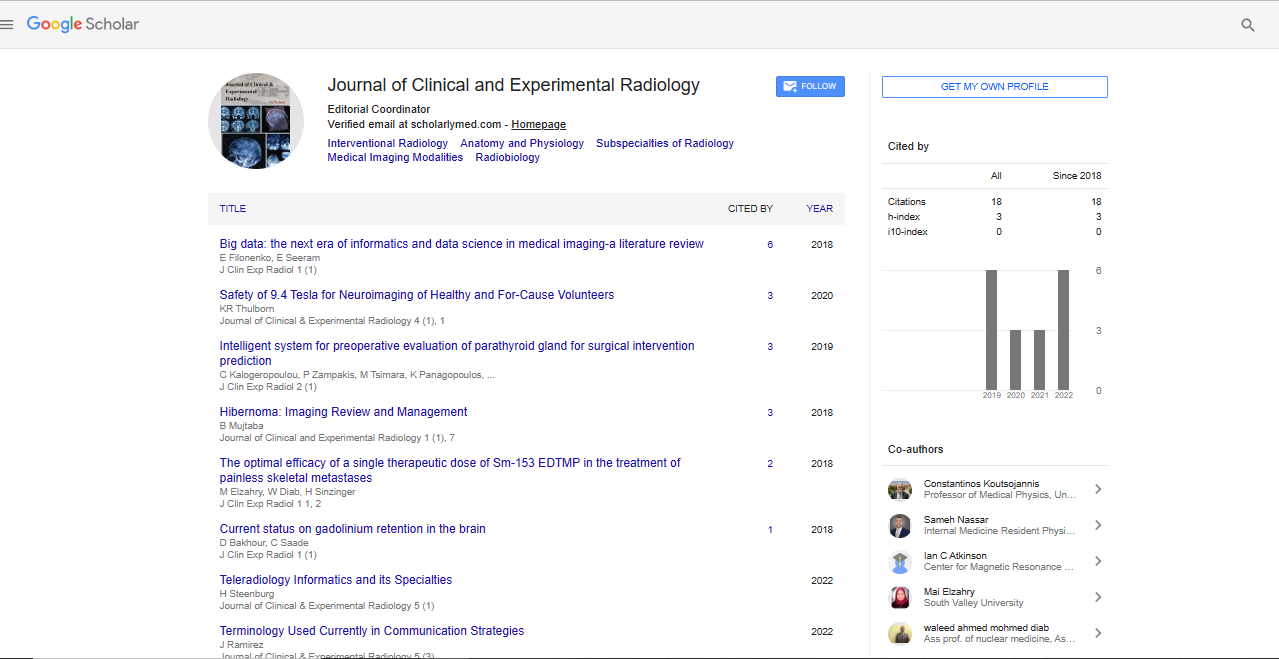Perspective, J Clin Exp Radiol Vol: 6 Issue: 1
Radiation Physics: Understanding the Basics and Applications for Everyday Life
Titania Evans*Department of Therapeutic Radiology, University of Groningen, Groningen, The Netherlands
*Corresponding Author: Titania Evans
Department of Therapeutic Radiology
University of Groningen
Groningen, The Netherlands
Email: evanstitania@gmail.com
Received date: 20 February, 2023, Manuscript No. JCER-23-96002; Editor assigned date: 22 February, 2023, PreQC No. JCER-23-96002(PQ); Reviewed date: 08 March, 2023, QC No. JCER-23-96002; Revised date: 15 March, 2023, Manuscript No. JCER-23-96002 (R); Published date: 22 March, 2023, DOI: 10.4172/jcer.1000127
Citation: Evans T (2023) Radiation Physics: Understanding the Basics and Applications for Everyday Life. J Clin Exp Radiol 6:1.
Description
Radiation physics is a branch of physics that deals with the study of radiation, which is the emission of energy in the form of waves or particles from a source. Radiation is a fundamental phenomenon that exists all around us and plays a crucial role in various aspects of our daily lives, from medical imaging to communication technologies to nuclear power generation. In this article, we will explore the basics of radiation physics, including the different types of radiation, their properties, and their applications in various fields.
Types of Radiation
Radiation can be classified into several types based on its nature and origin. The three main types of radiation are:
Electromagnetic radiation: This type of radiation includes waves of electric and magnetic fields that propagate through space at the speed of light. Examples of electromagnetic radiation include radio waves, microwaves, infrared radiation, visible light, ultraviolet radiation, X-rays, and gamma rays. Electromagnetic radiation is commonly used in communication technologies, medical imaging, and industrial applications.
Particulate radiation: This type of radiation consists of small particles, such as alpha particles, beta particles, and neutrons, which are emitted from the nucleus of an atom during radioactive decay or nuclear reactions. Particulate radiation can cause ionization of atoms and molecules, which can have biological effects and is used in various applications, such as cancer therapy, industrial radiography, and nuclear power generation.
Acoustic radiation: This type of radiation includes sound waves that propagate through a medium, such as air, water, or solids. Acoustic radiation is commonly used in medical imaging techniques, such as ultrasound, for imaging internal organs and tissues.
Properties of Radiation
Radiation exhibits several properties that are important to understand its behavior and interactions with matter. Some of the key properties of radiation include:
Energy: Radiation carries energy, which is the ability to do work or transfer heat. The energy of radiation depends on its frequency or wavelength, with higher frequency radiation having higher energy. For example, gamma rays have much higher energy than radio waves.
Penetration: Different types of radiation have varying abilities to penetrate through matter. For example, gamma rays can penetrate through most materials, while alpha particles can be stopped by a sheet of paper or a few centimeters of air. The penetration ability of radiation is utilized in various applications, such as medical imaging and radiation therapy.
Ionization: Some types of radiation, such as alpha and beta particles, can cause ionization of atoms and molecules by removing electrons from them. Ionizing radiation can have biological effects and is used in various applications, such as cancer therapy, sterilization of medical equipment, and industrial radiography.
Decay: Radioactive materials decay over time by emitting radiation. The decay process follows specific mathematical laws, and the knowledge of decay properties is essiential in various applications, such as radiometric dating and nuclear power generation.
Applications of Radiation
Medical imaging: Radiation is used in various medical imaging techniques, such as X-ray radiography, Computed Tomography (CT) scans, and nuclear medicine, to visualize internal structures of the human body for diagnosis and treatment planning.
Radiation therapy: Ionizing radiation is used in cancer therapy to target and destroy cancer cells. Techniques such as external beam radiation therapy and brachytherapy use radiation to treat various types of cancer, either alone or in combination with other treatments.
Industrial applications: Radiation is used in industrial processes, such as Non-Destructive Testing (NDT) and radiography, to inspect the integrity of materials, detect defects, and ensure quality control in manufacturing processes. Radiation is also used in sterilization of medical equipment, food irradiation for preservation, and in radiation processing of materials for various industrial applications.
Radiation physics is a fascinating field that has wide-ranging applications in our everyday lives. From medical imaging to cancer therapy to industrial processes to nuclear power generation to communication technologies, radiation plays an important role in various fields. Understanding the basics of radiation physics, including the types of radiation, their properties, and their applications, can provide us with valuable insights into the world around us and enable us to harness the power of radiation for various beneficial purposes.
 Spanish
Spanish  Chinese
Chinese  Russian
Russian  German
German  French
French  Japanese
Japanese  Portuguese
Portuguese  Hindi
Hindi 